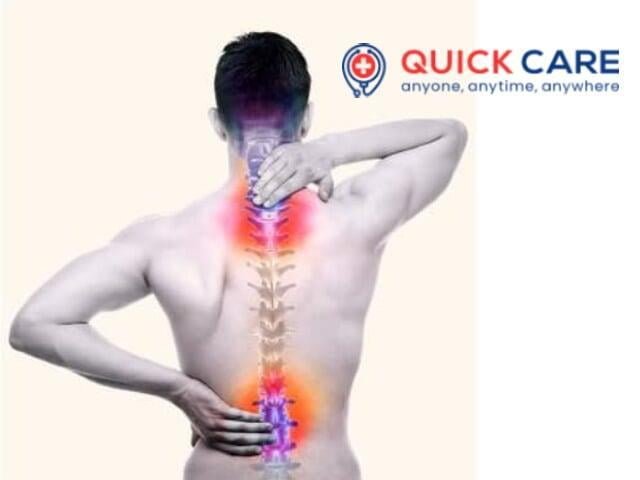Ankylosing Spondylitis disorder is an autoimmune disorder that may cause any of the spinal (vertebras) small bones to fuse over time. This fusion limits the backbone stability which can contribute to a steep stance. It can be hard to breathe deep while the ribs are impacted.
Men are affected more often than women by ankylosing spondylitis. In early adulthood, signs and symptoms normally commence. Inflammation may also occur elsewhere in your body particularly your eyes.
Ankylosing spondylitis should not be healed, but therapies can lessen the symptoms and slow the illness.
Spondylitis ankylosing in other regions of the body can also cause discomfort and steepness. There may also be other broad joints, for example shoulders, hips and knees.

The signs of spondylitis are distinct. It is also distinguished by mild to moderate inflammatory flare-ups that alternate with virtually no symptom cycles.
Ankylosing spondylitis disorder may be signs and symptoms early in your lower back and hips involving pain and stiffness, especially in the morning and after inactivity. Tiredness and neck pain are also common. Symptoms can deteriorate, change or cease at erratic intervals over time.
Back pain in the morning and in the night is the most frequent symptom. In broad joints, such as hips and shoulders, you can suffer too. The following may contain other symptoms:
Because ankylosing spondylitis requires inflammation, it may also affect other sections of the body. People with spondylitis will also undergo ankylosing:
While ankylosing spondylitis disorder is predominantly a spinal condition, other areas of the body also can be affected.
Spondylitis ankylosing has no clear cause, but there seem to be genetic causes. Persons with a gene called HLA-B27 in particular are very vulnerable to spondylitis ankylosing. However the disease only develops certain individuals with the gene.
There is no present treatment for spondylitis ankylosing, but medication will control discomfort and avoid incapacity. Proper care may lead to symptoms relief in due course. Often, potential problems such as bone deformation can delay or even stop.
Drugs/ Medicine
Nonsteroidal anti-inflammatory medications (NSAIDs) are also used to help treat discomfort and inflammation, such as ibuprofen and naproxen. They are long-acting medications with few risks and are normally effective.
If your doctor can recommend stronger medicines if NSAIDs no longer provide adequate relief. Corticosteroids are typically short-term administered. This is an effective fighter for inflammation such that symptoms can be relieved and the damage around the spine can be gradual.
Inhibitors of the Tumor Necrosis Factor (TNF) are medications which can block inflammation in the body. These medications inhibit inflammation and can reduce articular pain and rigidity. After a disease has advanced and NSAIDs are no longer successful, TNF inhibitors are generally used.
Finally, you can prescribe anti-rheumatic disease alteration medicines in serious cases (DMARDs). These medications delay the disease process in the body to avoid effects that deteriorate.
Operation/ surgery
A joint substitution surgery could be required if you have significant injury or deformity to your knees or hip joints. Likewise, persons with poor posture caused by fused bones should be automatically handled. A surgeon may cut and realign the bones in the spine during this operation.
The way the disease is critical and the symptoms problematic depend largely on treatment.
Difficulty
Fresh bones form part of the body’s effort at recovery in serious ankylosing spondylitis. This new bone fills steadily the distance between vertebras and finally fuses vertebrae sections. These spine sections become rigid and inflexible. Fusion will also reinforce your rib cage and limit the capacity and function of your lungs.
Additional risks may include:
An ankylosing spondylitis disorder is also used as a rheumatologist. This is an arthritis specialist surgeon.
A detailed physical examination is the first step. You will be asked by the doctor for information about your pain and symptom history.
Your doctor will use an X-ray to scan for spinal erosion and painful articulations. If the disease is in its early stages, erosion cannot be observed. There may also be an MRI analysis. However the findings of MRI are also hard to grasp.
The occurrence of any inflammation can be measured using a blood test known as an erythrocyte sedimentation rate. A HLA-B27 blood test can be performed. Neither do you have anchylosing spondylitis in the HLA-B27 test, however. You just have the gene that makes the protein.
If you have diagnosed with Spondylitis then make an appointment with QuickMdCare Doctors to get complete help to your problem. Quickmd Orthopedics will treat your spondylitis Disorder with optimal Solution.
© 2021 QuickMDCare. All Rights Reserved. Build with 🧡 by PPCROY